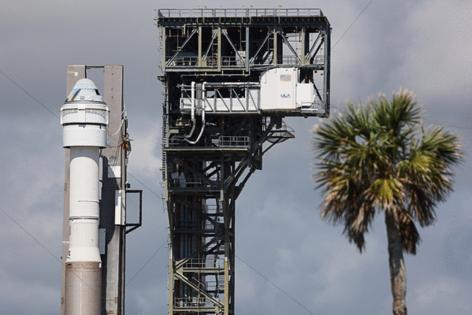Boeing faces critical launch Monday ferrying astronauts to the International Space Station
Published in News & Features
LOS ANGELES — Ferrying astronauts to the International Space Station has almost become routine — but not for Boeing and not on Monday, when after years of delay it's finally set to launch two crew members to the orbiting platform on a critical test flight.
The Arlington, Virginia-based aerospace giant was awarded a $4.2 billion contract in 2014 to build and operate a spacecraft to service the station, while El Segundo rival Space X received $2.6 billion to do the same.
Both were given out under NASA's Commercial Crew Program, established to have American companies taxi astronauts to the station.
The stakes are particulary high for Boeing. Since 2020, SpaceX completed its crewed test flight and has ferried eight operations crews to the base — while Boeing has managed only two unmanned flights, including one that docked remotely in May of last year.
Boeing has long-standing and historic ties to the aerospace industry in Southern California — the Apollo command and service modules were built at North American Aviation's plant in Downey. Its current operations include a satellite facility in El Segundo.
Boeing's new Starliner capsule was scheduled to launch with a crew last summer, but a problem was discovered with its parachute system and the use of flammable tape in the craft, a mile of which was removed. It was just the most recent of several delays.
Starliner, with crew members strapped in, is set to blast off at 10:34 p.m. Eastern time at Cape Canaveral Space Force Station in Florida. If the weather doesn't cooperate or other minor issues arise, it could fly the next day or later in the week.
After the delays and a reported $1.5 billion in cost overruns the company had to absorb, analysts say it's critical that the mission goes well. That's especially true, given Boeing's already battered reputation, after two crashes of its 737 Max 8 jets and a door plug that blew out of a 737 Max 9 flight this year on its way to Ontario International Airport in San Bernardino County.
"It's very important for [Boeing's] desire to be relevant to NASA, relevant to manned space flight and for confidence internally to turn around and execute a program that's had problems," said Ken Herbert, a Boeing analyst at RBC Capital Markets. "This could be a big win for Boeing, if they can successfully pull this off, just in light of all the bad news they get from every other part of the business."
The capsule is designed to be reused 10 times, similar to SpaceX's Dragon Capsule that services the station. It will be launched from an Atlas V rocket, a reliable workhorse built by the United Launch Alliance, a joint venture of Boeing and Lockheed Martin. Starliner should take about 26 hours to reach the station, which orbits at roughly 17,500 mph.
...continued
©2024 Los Angeles Times. Visit latimes.com. Distributed by Tribune Content Agency, LLC.







Comments